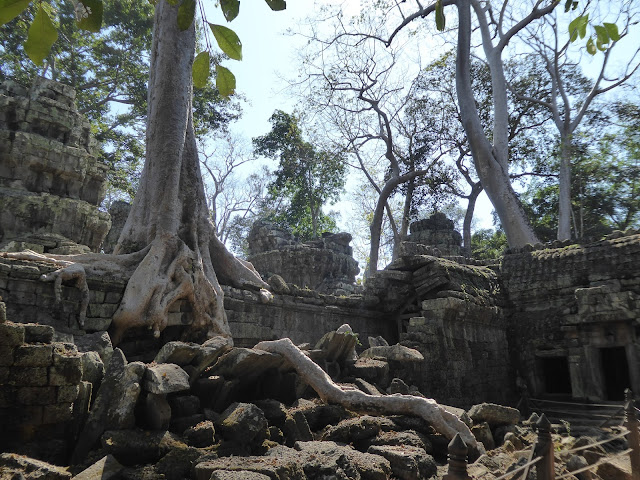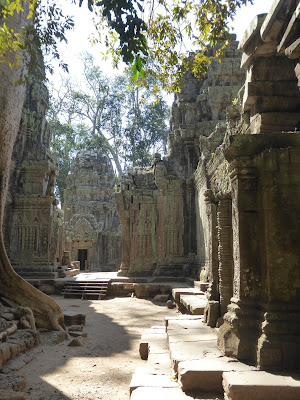 |
| Ta Prohm, Siem Reap |
Most people have heard of Angkor Wat, but not everyone realises that there are far more temples here than just the one. The Angkor area was the home of the Khmer Empire from the 9th to 15th centuries, and the various rulers built a succession of temples, most of which were dedicated to the Hindu God Shiva.
 |
| Ta Prohm, Siem Reap |
It is hot here, we don't like the heat, and we're not that energetic, so we had no desire to rush around, or to try to fit everything in at once. Neither are we generally that impressed by sunrises (we prefer sunsets), so we had no intention of leaving at 4am to stand in a huge crowd of people to see it.
We had plenty of time, so thought we would do four days of temple visits, and bought one of the $60 tickets that gives you up to seven days of entry over a period of one month. You can buy single day tickets at $20 and three day tickets at $40, so for four days, the longer ticket was the same price but gave us added flexibility. You stop at the entrance to get your ticket - you have to have your photo taken - and must keep it with you as they will ask to see it at each temple.
 |
| Ta Prohm, Siem Reap |
We decided that as we wanted to see four big temples and a number of smaller ones, we would do one main and a couple of others each on each trip, and we asked our driver to take us to the temples in whichever order would mean that they would be least busy.
That way, except for Angkor Wat itself, we did actually manage to avoid large crowds in most places. We left after breakfast, stopped for lunch if we felt like it, and got back to the hotel at a decent time to cool down and relax before dinner.
 |
| Ta Prohm, Siem Reap |
For our first day, our large temple selection, was Ta Prohm, which shot to fame as the temple with trees growing through it, in the Tomb Raider film and, having discussed our overall plans with the hotel staff and driver, the others for the day were to be Banteay Kdei, and Prasat Kraven.
Ta Prohm is always a popular temple, so we knew there would never be any chance of getting the place to ourselves. Our driver suggested going there first, as most tours do this temple in the afternoon.
And he was right. Whilst of course there were people around, you could find plenty of quiet spots on your own, and even the main places, you could get a chance of an empty photo if you were prepared to wait for a little while.
 |
| Ta Prohm, Siem Reap |
Given those numbers, as you can imagine, the whole complex is quite large. I don't know how hard it would to have been able to work your way around some of these temples when they were new, but in these larger ones, you could get lost pretty easily I suspect. Here, because of the large number of visitors, they have a one way system through the internal section, but at quiet times like this, they seem pretty relaxed about you backtracking.
As with most of the temples, there is an perimeter wall around the whole complex, and then a quite elaborate entrance through the square outer wall of the temple. Inside, there are two moats (although they are dry now) and then an internal wall, and the inner area has a number of courtyards.
 |
| Ta Prohm, Siem Reap |
The temple is certainly beautiful. It is, of course, rather dilapidated these days, despite work having been done to restore this one and many of the others.
The jungle reclaimed the temple hundreds of years ago, and while the area has been cleared they sensibly didn't try to remove the trees that have grown through the temple walls. It is fascinating to see the way the roots have penetrated and enveloped the stonework.
 |
| Ta Prohm, Siem Reap |
What we liked here, were the nicely preserved Devata bas reliefs. Bas reliefs are common throughout the temples, and are the decorative elements made by carving the stone walls back to leave the image or scene sticking out from the wall. The images are often female spirits, nymphs or minor deities, which are known as devata when they are standing upright as here. When they are depicted dancing they are known as apsara, and we will see some of those in later posts.
Our third temple was a very small one, Prasat Kraven. This 10th century is unusual for a couple of reasons. Firstly, it is one of the very few to have been built by a nobleman rather than a king, and secondly, it is a brick temple, and the only one where the bas reliefs are carved into the bricks, rather than stone.
  |
| Ta Prohm, Siem Reap |
 |
| Ta Prohm, Siem Reap |
 |
| Ta Prohm, Siem Reap |
  |
| Ta Prohm, Siem Reap |
 |
| Ta Prohm, Siem Reap |
 |
| Ta Prohm, Siem Reap |
 |
| Ta Prohm, Siem Reap |
 |
| Ta Prohm, Siem Reap |
 |
| Ta Prohm, Siem Reap |
 |
| Banteay Kdei, Siem Reap |
 |
| Banteay Kdei, Siem Reap |
 |
| Banteay Kdei, Siem Reap |
 |
| Banteay Kdei, Siem Reap |
 |
| Banteay Kdei, Siem Reap |
  |
| Banteay Kdei, Siem Reap |
 |
| Banteay Kdei, Siem Reap |
  |
| Banteay Kdei, Siem Reap |
 |
| Banteay Kdei, Siem Reap |
  |
| Banteay Kdei, Siem Reap |
 |
| Prasat Kraven, Siem Reap |
 |
| Prasat Kraven, Siem Reap |
  |
| Prasat Kraven, Siem Reap |
 |
| Prasat Kraven, Siem Reap |
 |
| Prasat Kraven, Siem Reap |
No comments:
Post a Comment
We like to hear from you too, so please leave us a message here. We are also happy to answer any questions if we can help. Comments are moderated so will not appear straight away and there could be some delay in replying if we are travelling.